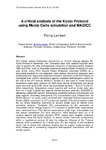A critical analysis of the Kyoto Protocol using Monte Carlo simulation and MAGICC
| dc.contributor.author | Lambert, P. | |
| dc.date.accessioned | 2019-05-15T13:50:42Z | |
| dc.date.available | 2019-05-15T13:50:42Z | |
| dc.date.issued | 2012 | |
| dc.identifier.citation |
Lambert, P. (2012) 'A critical analysis of the Kyoto Protocol using Monte Carlo simulation and MAGICC', The Plymouth Student Scientist, 5(2), p. 270-329. | en_US |
| dc.identifier.issn | 1754-2383 | |
| dc.identifier.uri | http://hdl.handle.net/10026.1/13994 | |
| dc.description.abstract |
The United Nations Framework Convention on Climate Change adopted the Kyoto Protocol in December 1997. Emissions data from national registries were used to quantify the total anthropogenic emissions of signatory parties between 1990 and 2009, found to have been reduced by approximately 18 percent of base year levels. Using IPCC Special Report Emissions Scenarios (SRES) as a practicable baseline for non-mitigation, three distinct intervention scenarios were constructed from target and observed emissions reductions under the Protocol to investigate their climatic implications against unabated anthropogenic carbon by the end of the 21st century. MAGICC Version 5.3 was used to model forecast trajectories under each scenario for both mean annual temperature and global mean sea level up to 2100, set to rise somewhere between 1.88-4.41°C and 27- 45cm respectively. Temperature output, together with archival model data, was then run through a global and regional climate scenario generator (SCENGEN), displaying substantial regional temperature variability between mid-latitudes and polar regions. Secondary atmospheric CO2 concentration data, collated from the NOAA Mauna Loa facility, were combined with Integrated Science Assessment Model (ISAM) projections for 21st century atmospheric CO2 concentrations under the six SRES illustrative scenarios to provide model input for Monte Carlo simulation analysis. Threshold CO2 concentrations for the prevention of irreversible climate change beyond a 2°C increase in global mean temperatures were calculated from IPCC defined assumptions under high, intermediate and low climate sensitivities. For each simulation, 1000 iterations were run in R console against intervention scenario KP18, based upon tangible emissions reductions under the Kyoto Protocol, to derive climatic threshold exceedences within a hypothetical century. At best the mitigative influence of the Protocol reduced such exceedence by a single year. For the majority of trial iterations Kyoto had no discernible influence alluding that its present implementation is likely inadequate in preventing dangerous anthropogenic interference with the climate system. | en_US |
| dc.language.iso | en | en_US |
| dc.publisher | University of Plymouth | |
| dc.rights | Attribution 3.0 United States | * |
| dc.rights.uri | http://creativecommons.org/licenses/by/3.0/us/ | * |
| dc.subject | Kyoto Protocol | en_US |
| dc.subject | climate change | en_US |
| dc.subject | United Nations Framework Convention | en_US |
| dc.subject | IPCC Special Report Emissions Scenarios | en_US |
| dc.subject | mean annual temperature | en_US |
| dc.subject | global mean sea level | en_US |
| dc.subject | MAGICC | en_US |
| dc.subject | Integrated Science Assessment Model | en_US |
| dc.subject | anthropogenic interference | en_US |
| dc.title | A critical analysis of the Kyoto Protocol using Monte Carlo simulation and MAGICC | en_US |
| dc.type | Article | |
| plymouth.issue | 2 | |
| plymouth.volume | 5 | |
| plymouth.journal | The Plymouth Student Scientist |



